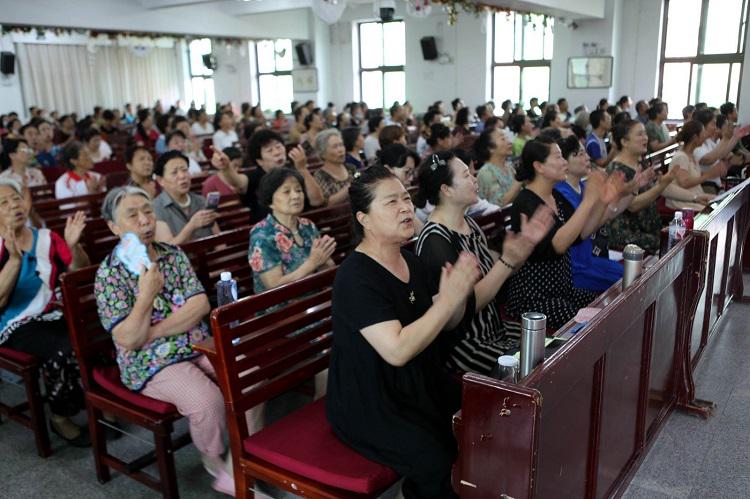Throughout the history of the Chinese church, sacred music has served not only as an essential part of worship but also as a distinctive form of witness and cultural expression. Brother Sun Zhipeng has devoted many years to collecting, organizing, and writing about sacred music. His works include Notes on the Lyrics of The Chinese New Hymnal, An Introduction to The Chinese New Hymnal, and Historical Background and Reference Materials on the Supplement to The Chinese New Hymnal. He also shares his reflections and biblical insights through online platforms and published writings. This article explores his journey and reflections on his ministry in sacred music and the written word.
Gospel Times: What inspired you to write the three books on sacred music?
Brother Sun: The Chinese New Hymnal was designed for urban believers with a moderate level of education, and its concise vocabulary can be difficult for many average believers to understand. When used in rural churches, numerous challenging phrases often arise. Coming from a rural background myself, I felt compelled to explain the complex lyrics so that believers could sing with both understanding and devotion. For example, "the silver cord will be severed" comes from Ecclesiastes and refers to the loosening of the spine after death; "oil running down on the collar of his robe" is from the Psalms; and "together we bear the yoke" originates from the Gospel of Matthew. I also clarified obscure expressions such as divine words (纶音, literally "the emperor's directive"), whisper and mutter (绵蛮, from Isaiah 8:19), and auspicious clouds (卿云), compiling them into Notes on the Lyrics of The New Hymnal.
As for An Introduction to The Chinese New Hymnal, during my time as choir director, I had long hoped to write an introduction to help choir members gain a deeper understanding of hymns during practice. However, due to limited resources, the project was postponed. Moreover, given the wide range of hymnals used by churches across the country and the absence of a unified authoritative hymnal, I was uncertain which one to adopt. The publication of The Chinese New Hymnal in 1983 allowed me to take up the work again. Since then, I have carefully followed hymn-related publications from churches in China, cataloging them one by one and compiling a Dictionary of Hymns and Hymnwriters for personal reference. This was not an easy task, particularly because inconsistent translations of names and my limited foreign language knowledge often made research difficult. Fortunately, the 1985 tablature edition of The Chinese New Hymnal helped resolve many of these challenges.
In my writing, I primarily consulted Introduction to Hymns and Hymn Authors and Hymn Stories by Bishop Wang Shenyin, published in Tianfeng (Heavenly Wind), the flagship magazine of CCC&TSPM, as well as Textbook, an internal Christian publication launched in 1980 to guide grassroots churches and promote the sinicization of Christianity in China. I also drew upon "Introduction to the Background of Hymn Creation" by Canyin, another contributor to Tianfeng.
Organizing information for 400 hymns was a complex and time-consuming process that required consulting every available source. As a rural youth with only a first-year middle school education, I often felt overwhelmed and doubted my ability to complete the task. Some might have thought I was overly ambitious. Yet, relying on the Lord's strength, I finally completed the first draft by the end of 1988.
The direct inspiration for compiling the Historical Background and Reference Materials on the Supplement to The Chinese New Hymnal came from the publication of The Supplement to The Chinese New Hymnal in 2009, which prompted me to begin collecting related materials. From 2019 to 2020, I published a series of 119 articles titled "Historical Materials of Hymns" in the Gospel Times. Unfortunately, due to restrictions, I was later unable to continue publishing.
In September 2019, I attended a preparatory meeting organized by Rev. Shan Weixiang, then vice president of the CCC, for the compilation of the Historical Background of the Supplement to The Chinese New Hymnal by CCC&TSPM. Also present were Rev. Zhou Yongci, a sacred music instructor at East China Theological Seminary, and Sister Li Qingyan of CCC&TSPM. At the meeting, I promptly submitted the historical materials I had collected for the 123 hymns included in The Supplement to The Chinese New Hymnal as reference material. Since then, I have continued to update and expand my work, completing 140 hymns by February 2023 and the entire supplementary history by June 2025.
During this time, I received encouragement and support from pastors such as Rev. Luo Liguang, former director of the Sacred Music Ministry Committee of CCC&TSPM and president of Jiangxi Provincial CC, and Rev. Shen Guangwei, former deputy director of the same committee and president of Liaoning Provincial CC. Pastor Luo, in particular, often prayed earnestly for this ministry. Whenever I encountered difficulties in writing, I would seek his guidance and prayers, to which he always graciously responded. His encouragement has been a lasting source of motivation in my work.
On May 30, 2025, upon seeing the "Notice on the Collection of Materials Related to The Supplement to The Chinese New Hymnal" issued by CCC&TSPM, I was deeply moved and immediately submitted my completed historical materials.
Gospel Times: In China, different churches have used various hymnals over time, across regions, and within different traditions. In your view, what are the features of The Chinese New Hymnal? How has it influenced the worship and faith life of today's Chinese churches?
Brother Sun: The New Chinese Hymnal is a nationwide collection of hymns produced through the careful collaboration of CCC&TSPM. According to its preface, it was compiled from hymnbooks used by different denominations, with many selections drawn from foreign church hymnals. Its content covers nearly every aspect of believers' faith and daily life, making it both comprehensive and spiritually enriching. Its profound influence on Chinese churches is unparalleled and cannot be replaced by any other hymnal.
Gospel Times: How do you understand the sinicization of sacred music? Are there any representative figures or works that reflect your understanding of this topic? In light of the sinicization of sacred music, what opportunities and challenges do you see for the development of hymns and sacred music in the Chinese church?
Brother Sun: "Indigenization," or "sinicization," is not an exclusive concept. It does not imply that the Chinese church should distance itself from the historical or ecumenical traditions of the global church, nor that Chinese Christians should refrain from singing foreign hymns. Rather, in a broader sense, it means that hymn creation should follow a distinctly Chinese path. At the grassroots level, believers naturally enjoy singing hymns with Chinese cultural characteristics.
The sinicization of hymns and sacred music begins with the lyrics. In principle, hymn lyrics should be written as beautiful poetry, not prose or other literary forms. Unfortunately, it has been somewhat relaxed in recent years. I believe, however, that lyrics and poetry are not entirely the same. Lyrics are meant to be sung, while modern poetry is not necessarily written with music in mind.
Generally speaking, hymn lyrics can be categorized into three types: slogan-like, direct, and soulful. Although society has largely moved past the "slogan-like" style, such repetitive and simplistic expressions still appear in church songs today, failing to convey genuine spiritual depth. In contrast, "direct" lyrics—written in clear, straightforward language—tend to be more meaningful. These hymns often articulate truth and doctrine, expressing the author's spiritual insight through subtle, concise, profound, and heartfelt language that is both beautiful and moving.
Melody is another key element in the sinicization of hymns. The pentatonic scale, composed of the five notes Gong, Shang, Jiao, Zhi, and Yu (do, re, mi, sol, la), is deeply rooted in traditional Chinese and folk music. This foundation has formed various folk scales and a distinct theoretical system that differs from the major and minor scales of Western music.
Equally important is the coordination between lyrics and melody. The style, tone, and rhythm of the music should clearly reflect that it is a Chinese song. A fundamental principle of Chinese music is "correct pronunciation and full intonation." One should not alter the natural tones of words or break up phrases simply to fit a melody, as musical flow must align with the rhythm and meaning of the lyrics. This is where Chinese and Western music differ most: the rhythm and intonation of Western languages differ greatly from those of Chinese. When foreign hymns are directly translated and sung in Chinese, the result often sounds awkward and unnatural, like a foreigner speaking Chinese, lacking fluency and coherence.
Gospel Times: Could you share your insights on the main types and characteristics of hymns in Chinese churches today?
Brother Sun: Hymns in Chinese churches today can generally be divided into four categories: traditional hymns, folk-style hymns, modern hymns, and large-scale hymns. Traditional hymns follow Western musical forms. Folk-style hymns are not pop music; they draw on local or ethnic musical traditions and are suitable for rural churches. Modern hymns incorporate contemporary musical styles but do not use rock music. Large-scale hymns are choral pieces of a certain complexity, designed for performance by choirs.
Among the forms of "modern praise" music, one prominent style is the increasingly popular "praise and worship" genre that has emerged in churches in recent years. This form originated from the Charismatic Movement. However, the extreme expressions of the Charismatic Movement often reflect radical or unsound theological ideas, which the Chinese church should firmly reject. We should instead preserve the vitality of the music while discarding its negative elements.
In my view, "modern music" refers to innovative, non-traditional approaches to melody, rhythm, harmony, and sound, using new techniques and musical language. Christian hymns can incorporate certain modern musical elements, but the goal should never be to chase trends. It should always be to glorify God more effectively. Rural churches tend to embrace hymns written in the style of folk songs, but these should not replace traditional hymns. In formal worship gatherings, traditional hymns should still be presented. Some churches have replaced their choirs' traditional hymn performances with modern "praise and worship" music, but this practice is inappropriate. "Praise and worship" music cannot, and should not, take the place of traditional hymns.
Gospel Times: In addition to your research and writing on sacred music, you have also published faith-related articles on various platforms and authored the book Reflections on Scripture. Could you share what writing means to your faith and ministry?
Brother Sun: I wouldn't call myself "one who serves through writing," but more of a "latecomer." My education ended after my first year of junior high school during the Cultural Revolution. Living in Wenzhou, a place where "heroes are judged by their eloquence," I have always felt that the city's churches are full of gifted preachers, especially during the period following the Cultural Revolution, when religious activities resumed. However, since the new millennium, I've noticed a decline in the quality of preaching in Wenzhou, with some even growing complacent and self-satisfied. However, when it comes to writing, few fall short apart from figures like Mr. Zheng Datong, Pastor Chen Fengsheng, and Pastor Lin Konghua. My efforts in this area stem mainly from personal interest and a desire to contribute.
Originally published by the Gospel Times
- Edited by Karen Luo and translated by Poppy Chan












